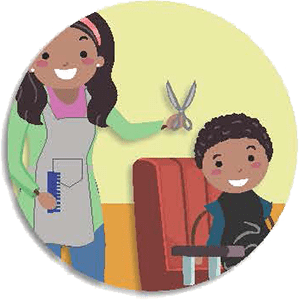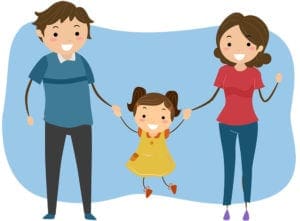It can be challenging for children with difficulties in sensory processing to tolerate routine grooming tasks, such as haircuts. Not because they are afraid of coming out of the appointment with bad bangs or an uneven trim, but because of the sensory response it evokes. See the Chicago Occupational Therapy blog post “What is Sensory Processing?” for more information about the different sensory areas and processing skills.
These sensory responses may be caused by tactile hypersensitivity (i.e., aversions to wet textures during hair washing), auditory over-responsiveness (e.g., aversion to sound of hair trimmers or scissors), and more. Below is more information about sensory responses, and strategies developed by occupational therapists that can be used to help children during haircuts.
Why do children with sensory issues struggle with haircuts?
If children have autism spectrum disorder (ASD) or sensory issues, they may be highly sensitive to sensory input: visuals, sounds, smells, touches or textures, and flavors. If a child is highly sensitive to touch, then there are already many aspects of a haircut that they will find highly upsetting, from pieces of their freshly cut hair clinging to the back of their neck to their hair stylist touching their head or neck during the trim.
If a child is highly sensitive to lighting, they might find that the bright lighting in most salons is not just uncomfortable, but overwhelming. There are also many different sounds in a salon, including loud conversation, hair dryers, running water, and the buzz of hair trimmers. Especially if you visit a salon that is typically bustling with activity, it can be difficult to shield your child from the unpleasant sensory input. However, there are many ways that you can help make the experience less traumatic.
5 tips for kids who hate haircuts:
1) Do your research on salons
If you notice your child is becoming overstimulated at bigger salons, perhaps there are smaller salons in your area that your child would find less overwhelming. There may be a facility that is relatively calm and quiet, which will better suit the sensory needs of your child. When you speak with the salon, it might be helpful to find out times when they are typically less busy, so you can schedule accordingly.
2) Utilize social stories or a visual schedule:
Many children on the spectrum benefit from social stories and visual schedules, and haircuts are no different. It may be calming for your child to see all of the steps of the haircut process laid out into a social story or visual schedule before going to the salon, to eliminate some of the unpredictability of the activity. You can purchase templates for both visual schedules and social stories at our Therapy Material Vault site.
3) Model behavior
The day or hour before the hair appointment, you could set aside time to have a pretend hair cut. During this time, you can model the appointment and explain (step-by-step) what will happen in the appointment. To make this more of a fun activity, you could have your child practice giving you a haircut. This may help reduce their worry, by making it a fun activity!
4) Schedule your cuts together
It might help to schedule your hair appointment on the same day. If you go first and your child is able to watch you calmly enjoy the experience, they might be more ready for their own haircut.
5) Bring a weighted blanket, sensory toy, headphones or ear plugs
The comfort of a weighted blanket can be helpful for an anxious child during a haircut. A sensory toy might also help to distract them. Additionally, playing soft, soothing tunes (i.e., spa music) through earphones or wearing noise canceling headphones or ear plugs could reduce the auditory input.
In addition to these suggestions, a pediatric occupational therapist can work with your child and family to address specific concerns related to sensory processing and grooming tasks. Contact Chicago Occupational Therapy or call (773) 980-0300 to learn more about our services and how we can help your child flourish and grow.



